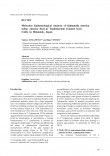Salmonella enterica subsp. enterica serovar Typhimurium is one of the most common causative agents of bovine salmonellosis. This review summarizes the molecular epidemiology of S. Typhimurium isolated from cattle in Hokkaido, Japan. The molecular epidemiology of 545 isolates collected between 1977 and 2009 from cattle in Hokkaido was investigated using pulsed-field gel electrophoresis (PFGE). Nine main clusters (I-IX) were identified by PFGE. Clusters I and VII were dominant in 1992-2002 and 2002-2009, respectively. Next, we analyzed the features of cluster I and VII isolates. Cluster I isolates produced the ADP-ribosyltransferase toxin, ArtA/ArtB which were fatal in mice. Cluster VII isolates were multidrug resistant and shared a virulence-resistance plasmid. Thus, epidemiological surveillance enables early recognition of epidemic Salmonella clones.

